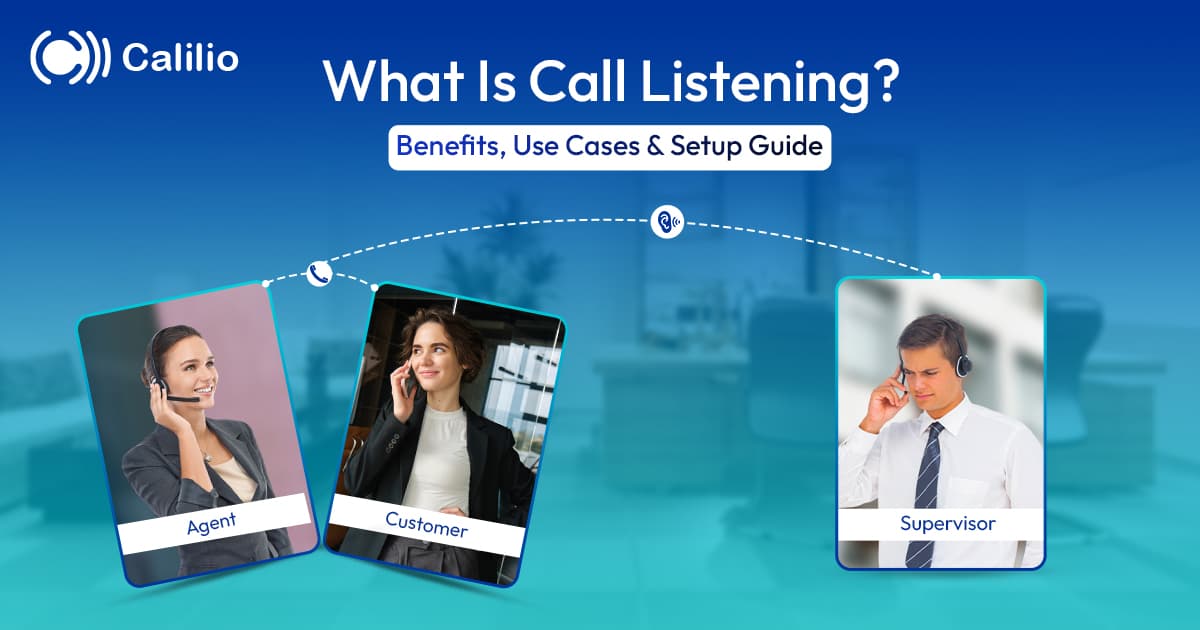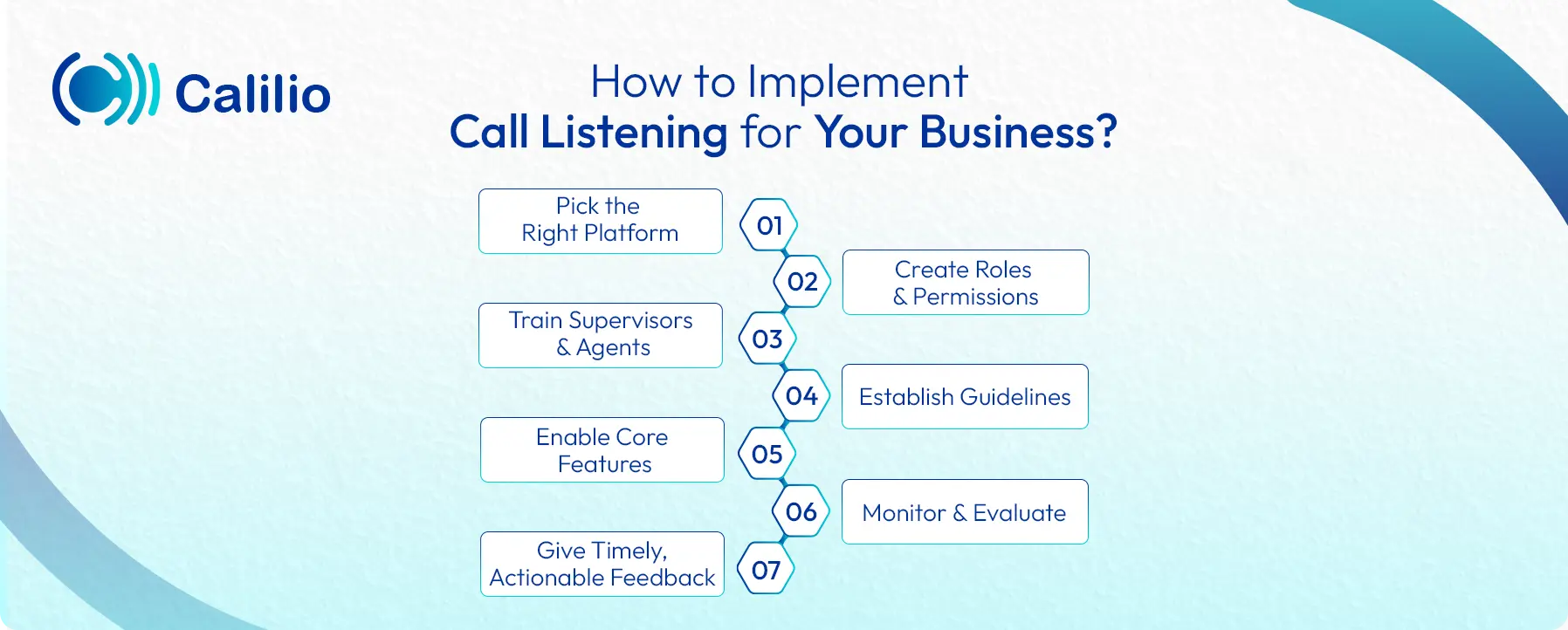What Is Call Listening? A Guide to Monitor Your Call for Quality Service

Good customer service is crucial for any business. If an agent gives wrong information, sounds uninterested, or doesn’t solve the problem, customers lose trust and may never return. When agent performance isn’t checked, these issues can quietly grow and harm the business.
Call listening lets you hear calls as they happen, so you can check if agents are polite, clear, and helpful. If you find any issues, you can instantly step in to guide them, fix mistakes quickly, and make sure every customer gets the right support.
In this guide, we’ll break down how call listening works, why it’s essential for business growth, and the best practices to implement it in your business.
What Is Call Listening?
Call listening is the process of monitoring live calls between company representatives and customers, typically for quality assurance, training, compliance, or performance evaluation purposes. It allows supervisors or quality analysts to silently “listen in” without interrupting the call, helping them assess agent performance, ensure compliance, and improve customer satisfaction.
Call listening captures the tone, pace, and emotion behind each exchange, offering valuable context. These insights help managers identify areas of improvement, provide targeted coaching, and maintain consistent communication standards.
How Does Call Listening Work?
Call listening works by allowing supervisors or managers to access live or recorded calls through call management tools. It uses different approaches to review and improve customer interactions. It uses tools such as call recording playback for reviewing past calls, call whispering for guiding agents, and call barging for joining the call directly when needed.
- Call Recording Playback: This method allows supervisors to listen to past calls saved in the system. It’s useful for detailed reviews, identifying recurring issues, and using real examples for training sessions.
- Call Whispering: Call whispering lets supervisors speak to agents during a live call without the customer hearing. It’s ideal for giving instant tips, correcting mistakes on the spot, and guiding agents through challenging conversations.
- Call Barging: Call barging allows supervisors to join a live call and speak to both the agent and the customer. It’s typically used when an urgent issue arises or when the agent needs direct assistance handling a complex situation.
Call Listening vs. Call Monitoring: What are the Differences?
Call listening involves reviewing recorded calls after they happen, mainly for training, quality assurance, and performance feedback. Call monitoring, on the other hand, happens in real-time, allowing supervisors to listen, coach, or intervene during live calls for immediate support and quality control.
Aspect | Call Listening | Call Monitoring |
Purpose | Primarily for training, performance review, or quality assurance via recorded calls. | Broader term that includes real-time evaluation of live calls for multiple purposes. |
Tools Used | Call recording systems, playback tools, QA dashboards. | Real-time monitoring tools, whisper/barge-in features, live dashboards. |
Level of Involvement | Mostly passive (since actions are taken only after completely reviewing the calls). | Mostly active (since supervisors can intervene or guide live). |
Use Cases | Coaching, compliance reviews, customer experience analysis. | Live support, escalation handling, immediate quality assurance. |
Feedback Style | Delayed (since feedback is given after analyzing the full call). | Instant (since real-time corrections or guidance is possible via whisper or barge-in). |
What are the Benefits of Call Listening in a Business?
Call listening helps businesses gain insights into customers’ needs, improve customer satisfaction, and ensure compliance during customer interaction. It also helps to identify the performance gaps in the customer service and provide the training to the agents accordingly.

1. Gain Insight Into Customer Needs and Pain Points
By actively listening, you can identify the exact customer query or issue that your agent may have missed. These insights help you understand what your customers want and where your service is falling short.
2. Train and Coach Agents With Real-World Conversations
Supervisors can use real examples to coach agents on tone, accuracy, and handling objections. This helps agents improve their skills more efficiently and effectively.
3. Ensure Compliance and Reduce Risk
Call listening ensures your agents comply with company policies. Detecting risks early helps you avoid penalties, maintain customer trust, and protect your brand reputation.
4. Enhance Customer Satisfaction and Retention
By understanding customer needs and coaching your team accordingly, you can improve your service quality. This leads to quicker resolutions and more satisfied customers.
Call Listening Use Cases
Businesses primarily use the call listening approach in departments such as customer support, sales, and training and onboarding. In each of these areas, it helps improve business communication, boost performance, and deliver better customer experiences.
1. Customer Support
In customer support, call listening helps managers track how agents handle different types of queries. Supervisors can listen to live calls or review recordings to spot service gaps, tone issues, or missed opportunities to resolve problems on the first call. The quick resolution enhances customer satisfaction and helps build trust.
2. Sales Teams
Sales managers use call listening to evaluate how agents handle objections, present product benefits, and close deals. By listening in, they can offer real-time guidance through call whispering or follow up with targeted coaching sessions. This not only improves conversion rates but also ensures the sales pitch stays consistent across the team.
3. Training and Onboarding
Call centers can use call listening to shadow calls, providing new hires with real examples of how calls should be handled. Trainers can play recorded calls to show best practices or let new agents listen to live conversations. This makes it easy for the new joiners to learn quickly and build confidence faster.
How to Implement Call Listening for Your Business?
To implement call listening in your business, start by selecting a reliable call center or VoIP platform that supports live listening. Once in place, train your agents on its purpose, assign permissions to supervisors, and enable the required monitoring settings. Then, you can monitor calls regularly and provide timely, actionable feedback to drive continuous improvement.

1. Pick the Right Platform
Choose a VoIP or call center solution that supports call listening, monitoring, and recording.
2. Create Roles and Permissions
Assign call listening permissions to supervisors, managers, or quality analysts only.
3. Train Supervisors and Agents
Before rolling out, train supervisors on how to use the call listening features effectively. Show them how to join calls, use whisper mode, and log feedback.
4. Establish Guidelines
Follow local call monitoring laws - some regions require one-party consent, others two-party consent. Update your IVR messages or call scripts to inform customers when calls may be monitored.
5. Enable Core Features
From your platform’s admin panel, activate the setting to listen to the calls.
6. Monitor and Evaluate
Track your listening sessions over time to see how agents are progressing. Evaluate the effectiveness of your strategy by measuring key call center metrics like CSAT (Customer Satisfaction Score), FCR (First Call Resolution), and AHT (Average Handle Time).
7. Give Timely, Actionable Feedback
Share feedback as soon as possible - ideally on the same day. Use real call examples to highlight strengths and address weaknesses.
Wrapping Up
Call listening gives you insights into customer needs, identifies the service gaps, and guides your team to deliver better customer service. When implemented with the right platform, clear compliance policies, and consistent coaching, call listening transforms everyday calls into opportunities for improvement.

Get Cashbacks Up to 43% Straight To Your Wallet!
Unlimited Virtual Numbers – Local, Mobile & Toll-Free from 100+ Countries
Free Local Phone Number from US or Canada
Crystal-Clear Calls Starting at Just $0.0153/min
24/7 Human Support – Because Great Service Never Takes a Holiday


Frequently Asked Questions
What is the difference between call listening and call recording?
Call listening allows supervisors to listen to live calls in real time. In contrast, call recording stores calls for later review and analysis but doesn’t allow for live intervention or coaching.
Is call listening legal?
What Is the Reason for Call Listening?

Still have questions?
Can’t find the answer you’re looking for? Please chat with our friendly team.
Stay in the loop
Get the latest call insights, trends, and updates delivered straight to your inbox.
By subscribing, you agree to receive updates from Calilio.
You can unsubscribe anytime.